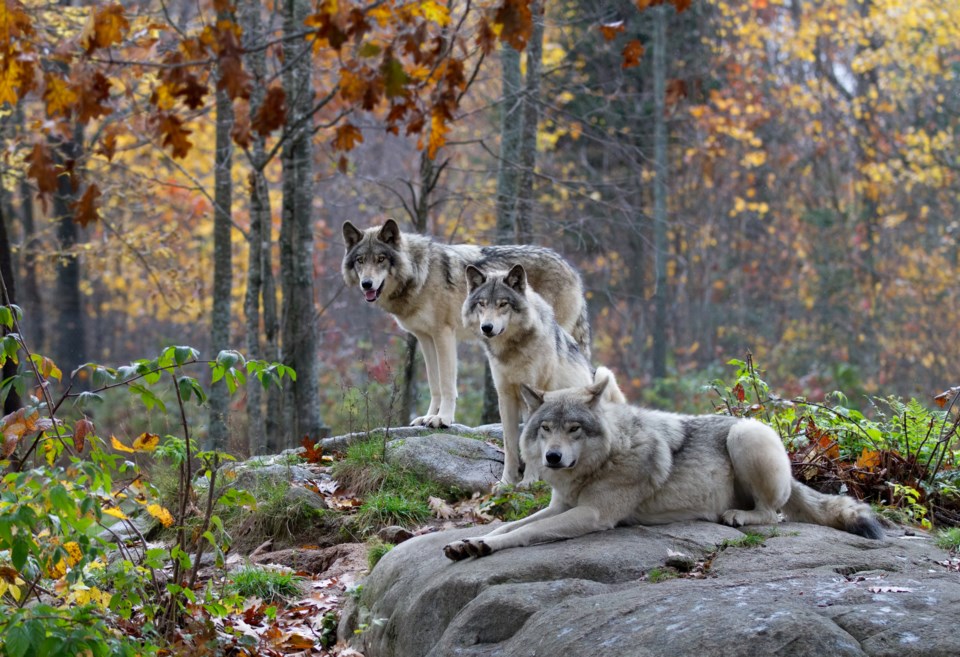My first near-wolf experience was in a forestry cutblock. I heard the wolf’s howl rise like a ghostly siren. I couldn’t see the wolf because it was obscured by dense regrowing aspen saplings in a previously harvested stand.
In Canada’s boreal forest, wolves have to adjust to the widespread landscape changes left by petroleum extraction and forestry. Being smart, wolves have turned these new human-made landscapes to their advantage. Mature forest is replaced by young forests, which provide attractive environments for , bolstering wolf populations.
Wolves respond to changing environments in the north by adapting to available prey. Boreal wolves hunt large ungulates: . But the western Canadian boreal forest is changing rapidly, . Wolves use and petroleum-exploration to .
The combination of wolves and environmental changes brought about by resource extraction .
Wolf culls
Governments have made the tough call to kill wolves to save caribou, that has spurred much public outcry and debate. While wolf culls , culls remain mired in some mystery: exists on their side-effects for surviving wolves, or the animals they live with.
We tackled this problem in northeastern Alberta, where we had been using to research and the .
After three years, the government launched a multi-year wolf population reduction program in our study area, using collared wolves as “Judas wolves” to locate packs for aerial gunning. We quickly responded by redeploying our camera-trap array for another three years, giving us some of the only before-and-after data on the entire mammal community for any wolf control program in North America.
Time management
Our first research was on wolf behaviour: what do surviving wolves do after a strange aerial predator starts killing neighbours? One aspect of a species’ behaviour is time: species use the day in different ways to deal with different challenges. The time-stamped photos from remote cameras .
Wolves, being highly adaptable, , and turned to darkness. Before the cull, wolves were normally active during daylight hours, with small peaks between sunrise and sundown, with a slight dip around noon. After wolf control, surviving wolves shift into nighttime hours, with activity peaking just before midnight and again just before sunrise.
Activity from sunrise to sunset was much lower, and almost nonexistent at midday. The cover of night allows them to avoid aerial gunning. In fact, many mammals — — are becoming nocturnal to avoid human disturbance.
But animals often . We expected that other animals might also change their habits to avoid newly nocturnal wolves. But this was not the case: lynx, coyotes, black bears, moose, deer and caribou all went about their normal business hours.
Better decisions
After shifting their time of day, wolves’ daily activity patterns no longer overlapped heavily with their big prey: deer, moose and caribou. Instead, their activity overlapped markedly with smaller snowshoe hares. In effect, wolves become “temporally decoupled” from their big prey.
We still don’t know if this behavioural change will have ramifications for wolves’ diet and prey populations. If wolves are not active at the same time as large ungulates, predation rates decrease. This will likely contribute to recovering caribou population growth.
Conversely, if predation on white-tailed deer decreases, it may allow this invasive species to expand. And if wolves switch to hunting snowshoe hares, there could be adverse effects on coyotes, lynx, fishers and other carnivores that rely on hares for food.
As a society, we made the difficult decision to kill wolves to save caribou. The onus is now on us to learn all we can from this decision, to better understand how boreal animals use their landscapes — and better plan for resource development, so we never have to make this decision again.
![]()
Jason T Fisher receives funding from Government of Alberta, Environment and Parks.





